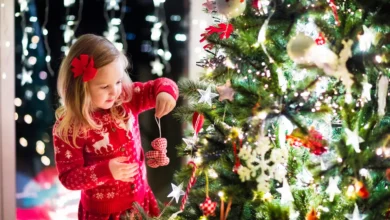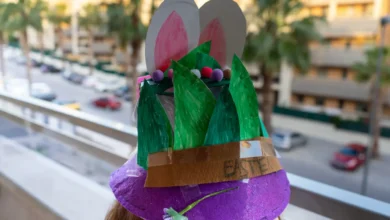Make bunny prints using glitter or some soft fur to add a magical touch. Watch as evidence vanishes overnight by leaving some bunny food out like carrots or sweets. Magic eggs can be used to hide hidden treasures for your loved ones, and a chocolate bunny trail will certainly make them laugh. You can add a cute and funny twist to your sleepy faces by painting them with noses or whiskers of bunnies.
These creative tricks will delight both children and adults and add a little excitement and wonder to your Easter celebrations. Here are some creative and fun ways to prove the Easter Bunny was at your house.
A Tiny Bunny Note Left Behind:
1. Make Sparkly Bunny Prints
Leave some bunny tracks as proof that Mr. E.B. Leave some bunny footprints to prove that Mr E.B.
These glittery prints are a great alternative to the traditional flour and chalk bunny print. These prints are made by mixing glitter with baking soda and applying it using damp sponges.
2. Leave Some Bunny Fur
Cotton wool is as soft as bunnies, so you can pull some apart and make a trail with their fur to the eggs they have hidden!
You can also have an Easter egg hunt in the morning by leaving the cotton wool “fur” scattered around the house and garden.
3. Keep Some Bunny Bait Out
The Easter Bunny is fond of carrots. He loves chocolate, but he also likes to snack occasionally on healthy foods to keep himself going during his long night of travels for Easter! Get the kids to give him some carrots and water on Saturday night to help recharge his batteries. You can take a bite of the carrot or a sip before going to sleep.
You can also give him ‘bunny bait’ if your children aren’t convinced. In a paper cup or small bowl, combine a variety of foods such as popcorn, pretzels and M&Ms with white chocolate. He’ll be unable to resist!
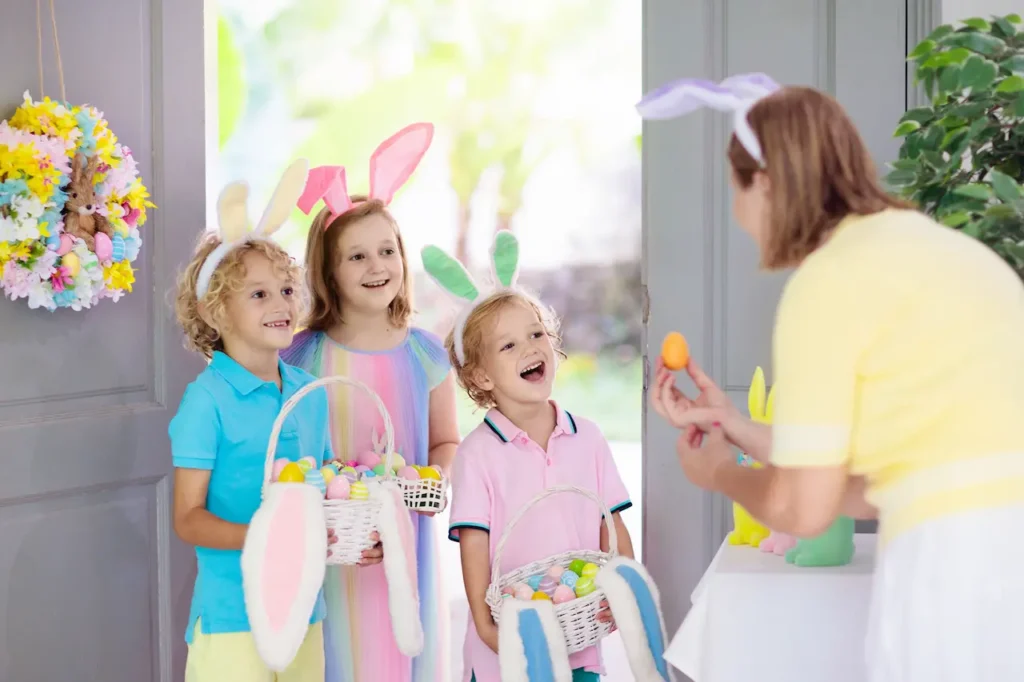
4. Magic Eggs are a Great Way to Surprise Your Loved Ones.
Food coloring can be used to dye your raw eggs in the refrigerator after the kids have gone to bed. Put the colorful shells in the refrigerator and act surprised when you take them out for breakfast.
If you don’t want to color them, just draw cute bunny faces using a black pen. Easter Bunny has to have worked his magic!
5. Paint Your Sleeping Faces
If your children are chronic sleepers, you can draw whiskers and noses on their faces as they sleep.
You can wash it off the next morning if you use washable face paint instead of regular face paint. Tell them to check in the mirror when they wake up and see what the Easter Bunny did!
If your child is looking to get rid of the bunny, use a washable light-coloured marker. It can be cleaned with soap and water.
6. Bunny Poo Trail
This is perfect for your kids who love poo humor! The Easter Bunny scatterings look better than the bunny’s. You can also leave some magical rabbit poo. Leave some a Yum!
We wish our Baby Domain an Easter full of joy, no matter how you decide to “prove” that the Easter Bunny is at your house!
Where Did The Easter Bunny Originate?
The Easter Bunny was first mentioned in the 19th century. It is now the most popular symbol for the Christian holiday Easter. Germans had an Easter tradition where they would create nests to allow an egg-laying hare, called “Osterhase” or “Oschter Haws“, to lay eggs. The Easter Bunny hides eggs, and the children create decorative baskets.
Easter is about new beginnings and new life. Both eggs and rabbits are symbols of this. According to Christian belief, Jesus arose from the dead and had a brand new life. Rabbits have a reputation for producing many babies, which is the reason they are a symbol of new life. Hatching eggs into chicks is also regarded as rebirth.
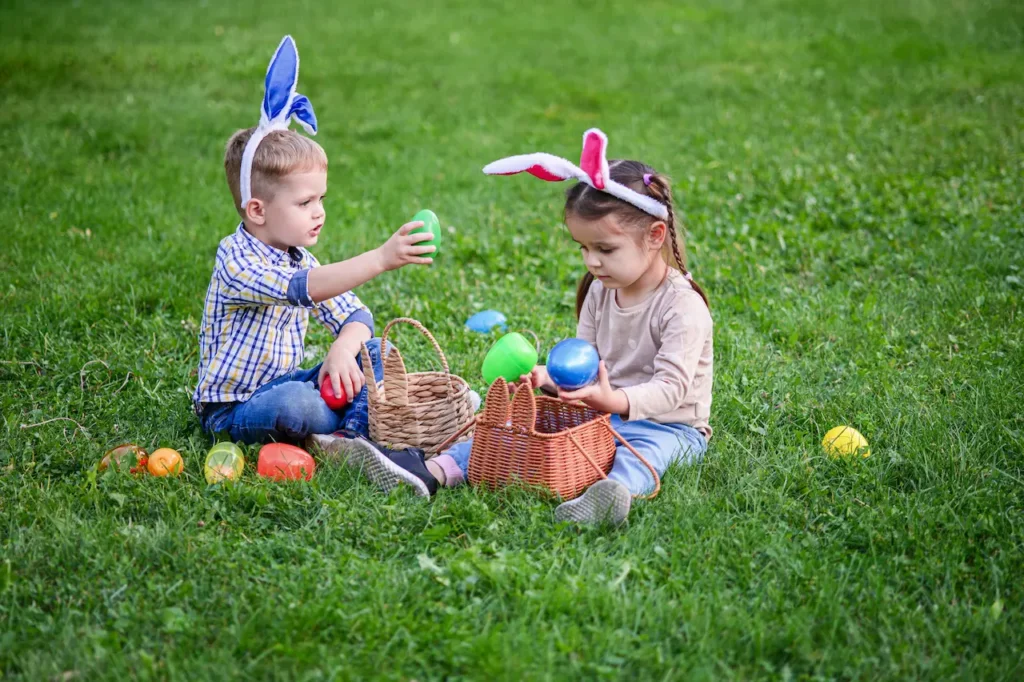
Rabbits have long been associated with fertility and new life, even though the story was first told in the 19th Century. Eostre was the Anglo-Saxon goddess of spring. She was usually depicted with a basket. She was sometimes depicted as a hare.
The Christian faith adopted the rabbit symbol as early as the 19th century. According to Christian myth, there was a bunny in the Garden of Gethsemane waiting outside Jesus’ grave. The rabbit patiently waited until Easter Sunday, when Jesus rose. Rabbits, a Christian symbol of fertility and rebirth, are often associated with Mary.
Easter Bunny History
In the United States, it’s well-known that the Easter Bunny is known for laying eggs on Easter Sunday. Every year, children eagerly rush to their Easter baskets to find out what kind of chocolates and special treats the mythical furry creature has left for them. The Easter bunny is a mysterious creature, much like Santa Claus or Christmas. It has no connection to the Christian meaning of the post-Lent holiday. Where did the Easter Bunny come from?
What is the point of starting?
Easter Bunny is a pagan tradition that originated around the time of the vernal or spring equinox. This also happened to coincide with the Christian celebrations of Jesus Christ’s resurrection and death. Pagans celebrated springtime fertility and the renewal of life, as well as Eastre, the goddess of dawn. Easter, the goddess of spring and fertility, was linked to newborns both humans and animals. Since rabbits are rapid breeders, this concept evolved. According to legend, the goddess Eastre arrived “late” in one year and caused a long, cold winter. She saw a bird frozen in the snow. Easter turned the bird into a snow hare that could lay multiple colored eggs one day a year, the day of the Easter festival.
In the 17th century, in Germany, the Christian holiday and the pagan Easter bunny began to merge. Missionaries often “practiced some good salesmanship,” incorporating pagan holidays into Christian ones as the Christian religion spread. This is what happened to the “Easter” rabbit. Germans transformed the pagan rabbit into “Oschter Haws”, a rabbit that laid colored eggs for children who behaved well.
According to the German National Tourist Board, Dutch settlers introduced the Easter Bunny in America during the 17th century. The German National Tourist Board reports that their children made nests from the hats and bonnets of their parents in hopes the “Oschter Haws”, the Easter Bunny, would leave coloured eggs.
According to Catholic Online, while the Easter Bunny has a long history of pagan associations, it also has a Christian connection that dates back to the ancient Greeks who believed rabbits were virgins and could reproduce. In the medieval period, paintings and manuscripts depicted rabbits alongside Mary. German Protestants popularized the Easter Bunny myth as a child’s story.
We may never be able to tell if it was Christian or pagan associations with the bunny that influenced Germans. One thing is for sure: the Easter Bunny continues to bring joy to children all over the country on Easter Sunday.
Why Do Easter Eggs and Bunnies Exist?
Around April, the stores are filled to the brim with pastel-colored decor, plastic eggs filled with jelly beans, and of course, everything rabbit-themed.
Easter is a religious holiday and the unofficial beginning of spring for the northern hemisphere. How did rabbits become involved with this holiday? Where do they get their eggs from?
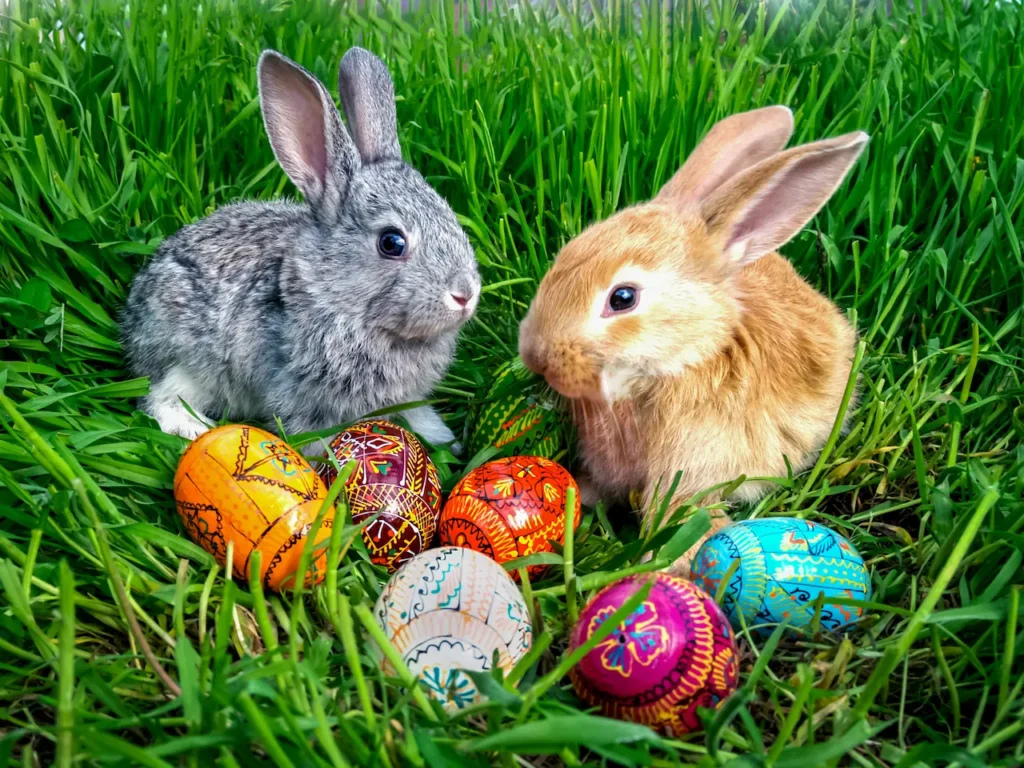
Origins of Easter Traditions
Easter is originally known as Pascha (and it’s still celebrated in Eastern European communities). Pascha comes from the Greek words, Hebrew and Aramaic for the Passover celebration, which is a Jewish festival. Pascha was celebrated by early Christians to commemorate Jesus’ death and resurrection as described in the Christian Bible. As the church grew, the name Passover began to refer to this celebration of resurrection.
As the church expanded and grew across Eurasia, Europe, and Asia, celebrations and customs changed as new cultures, languages, and communities evolved. As the church grew, celebrations before and after Pascha were added to the religious season. Different nations also incorporated their own culturally important traditions.
Easter in America today is a far cry from the celebrations of nearly 2000 years ago. Two millennia of culture have influenced the holiday. Not to mention, the importance that the church has played in its history.
Let’s look at the origins of some of today’s commercial Easter celebrations in the United States and see why they are still celebrated. For example, a rabbit delivering eggs became a symbol of spring around Easter.
Where Did Easter Eggs and Easter Bunnies Come From?
Easter is a celebration that has its origins in Christian traditions, but the Easter Bunny and its abundance of gifts are not part of the original festivities. Halloween and St. Patrick’s Day are just two of the many celebrations and holidays we celebrate today. As an example, people combined religious holidays with local belief systems to create new customs that allowed communities and individuals to celebrate in a way that was more meaningful to them.
Easter Bunny
There is evidence that links the hare with the goddess Eostre, and her fertility.
The rabbit, thanks to its penchant for multiplying so quickly When German immigrants first arrived in America in the early 1800s, they brought the Easter stories and traditions with them. The Easter Bunny, the Easter Hare, and the Easter Bunny evolved from the Easter Hare and the decorating of eggs.
Easter Eggs
The egg has long been a symbol of fertility, life and death. In various parts of Africa, decorated ostrich eggs date back nearly 60,000 years ago. Ancient Egyptians and Sumerians buried golden eggs in their tombs even as late as 3,000 B.C.
Early Christians dyed red eggs to represent the Crucifixion at Easter. As the religion spread, the practice also did. During the medieval Lent celebrations, which preceded Easter, eggs were forbidden. People would decorate and paint them to signify the end of fasting.
What is the Origin of the Word “Easter?”
Easter is celebrated in the springtime, with pastel colors and baby chicks, as well as daffodils and fresh flowers.
Ancient cultures also celebrated spring with feasts and festivals that were dedicated to pagan gods. Ancient Greeks had Persephone as the goddess of spring growth. Brigid was the Celtic Goddess of Fire and celebrated early February, to celebrate the return of light and the start of spring.
Flora was a Roman goddess of spring and flowers, as was Greek ora. was worshipped by ancient Slavics as the god of spring, fertility, and vegetation. Native Americans in North America had stories and legends about the seasons, such as Morityama the God of Spring, or Sig-Wan the Algonquin. Norse people had Freyja as a fertility goddess.
In West-Germanic regions, Saint Bede, an eighth-century monk, wrote that Pascha (or “Month of Eostre”) was known locally as Eosturmonath. This was the time of pagan feasts and festivals celebrating the arrival of Spring. Eostre’s month became synonymous with Pascha and was associated with fertility, new life, and spring. The name was eventually changed to Easter.
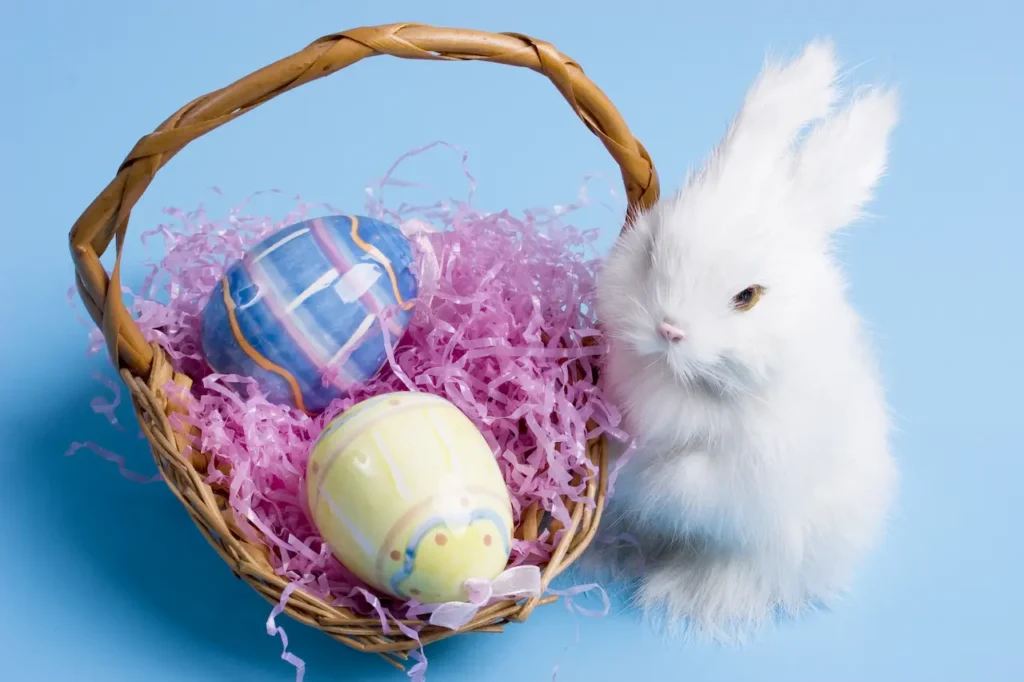
Easter Tradition
I love the traditions that involve tangible objects used every year. When I touch something that my grandmother and great-grandmother used or touched every year for their celebrations, I feel a connection. This is never more apparent than during Easter.
When my children were born I bought each one a wooden Easter basket made in the year they were born. Although it was expensive, I never bought them another basket.
It has been a joy to fill those baskets before Easter and set them out on Easter morning. As I prepare them for Easter and church, I love to see their joy as they search through their baskets and find the trinkets that I have hand-picked just for them.
This memory has raised some questions. Why is a rabbit associated with Easter? And why, among other things, should that bunny be expected to give out eggs? Since we know bunnies do not lay eggs, the connection was a mystery. I decided to do some research.
As a Christian I’ve always believed – and made sure that my children knew – the true meaning of Easter. Easter is a pivotal day in our Christian faith.
In John 19:41-42 States
There was a garden near the spot where Jesus had been crucified. In the garden was a brand new tomb in which no one had ever been buried. It was the Jewish Day of Preparation, and the tomb was close by. So they laid Jesus in the garden.
Three days later Jesus rose from death, leaving an empty tomb behind, and revealed himself to different people at various times. It was a wonderful day for the believers of that time and us as well.
